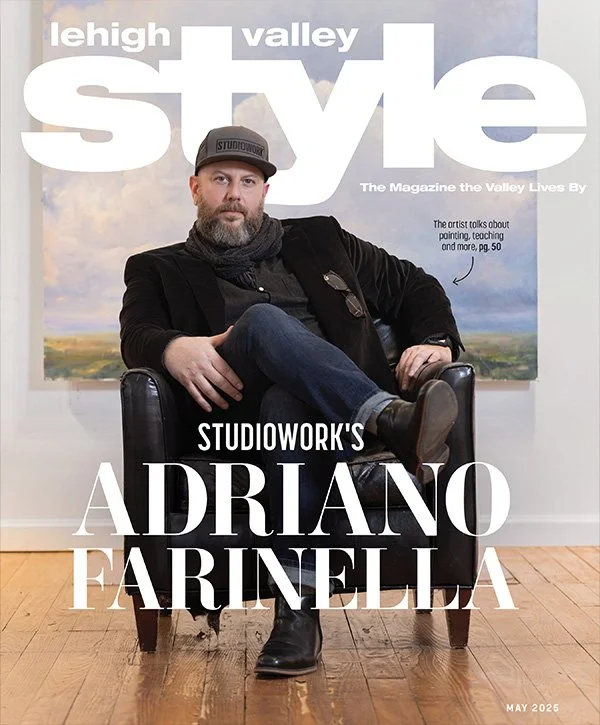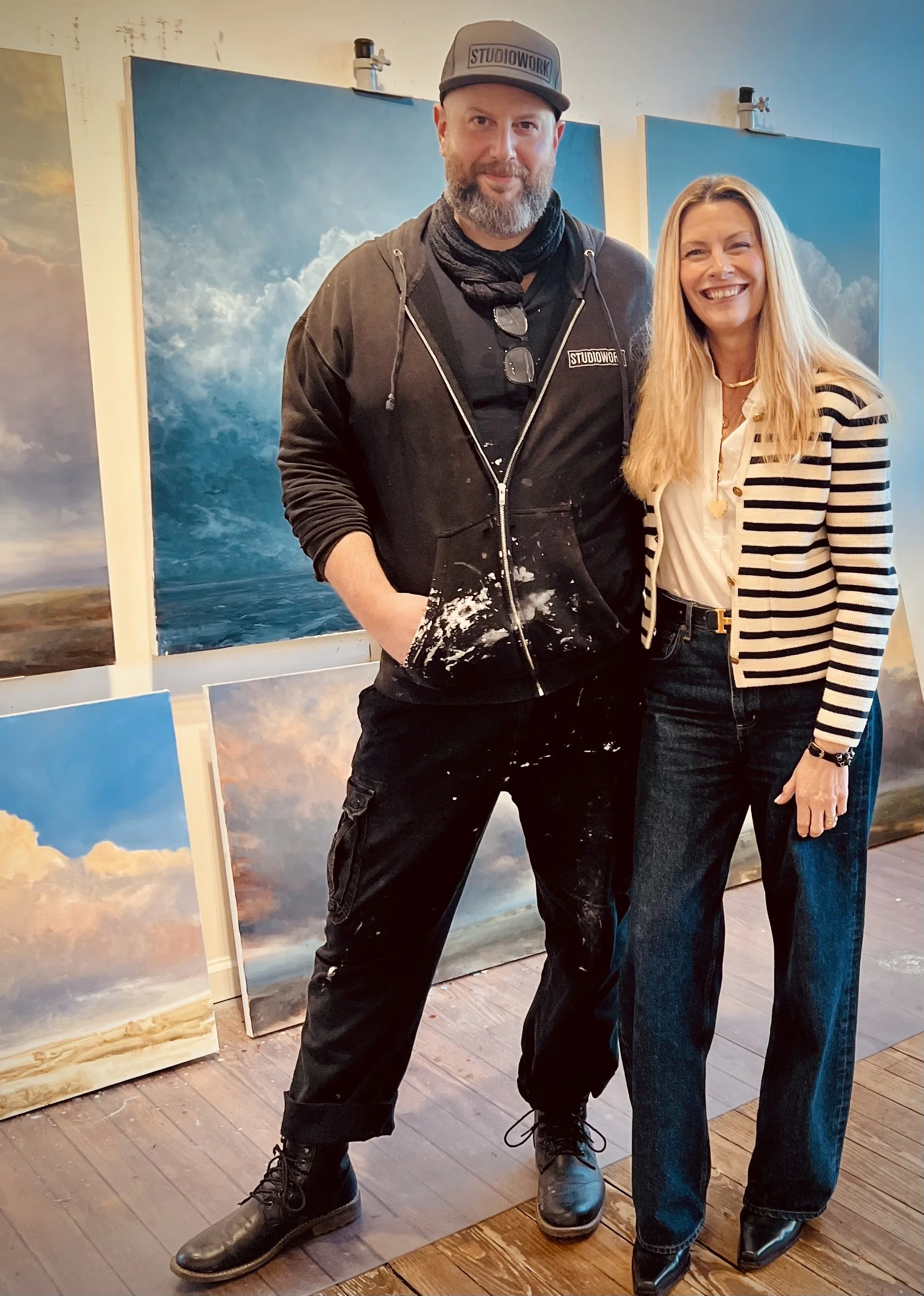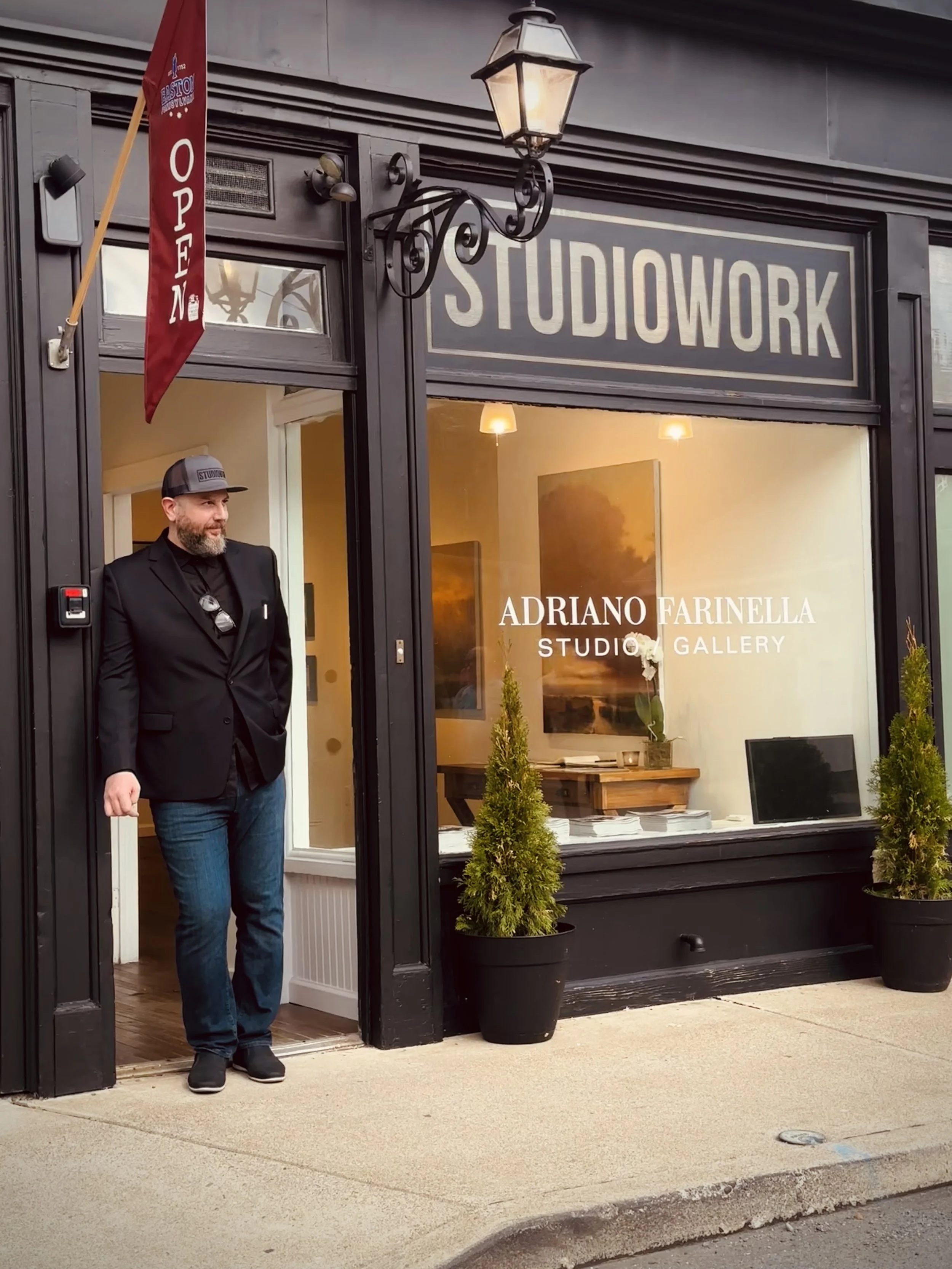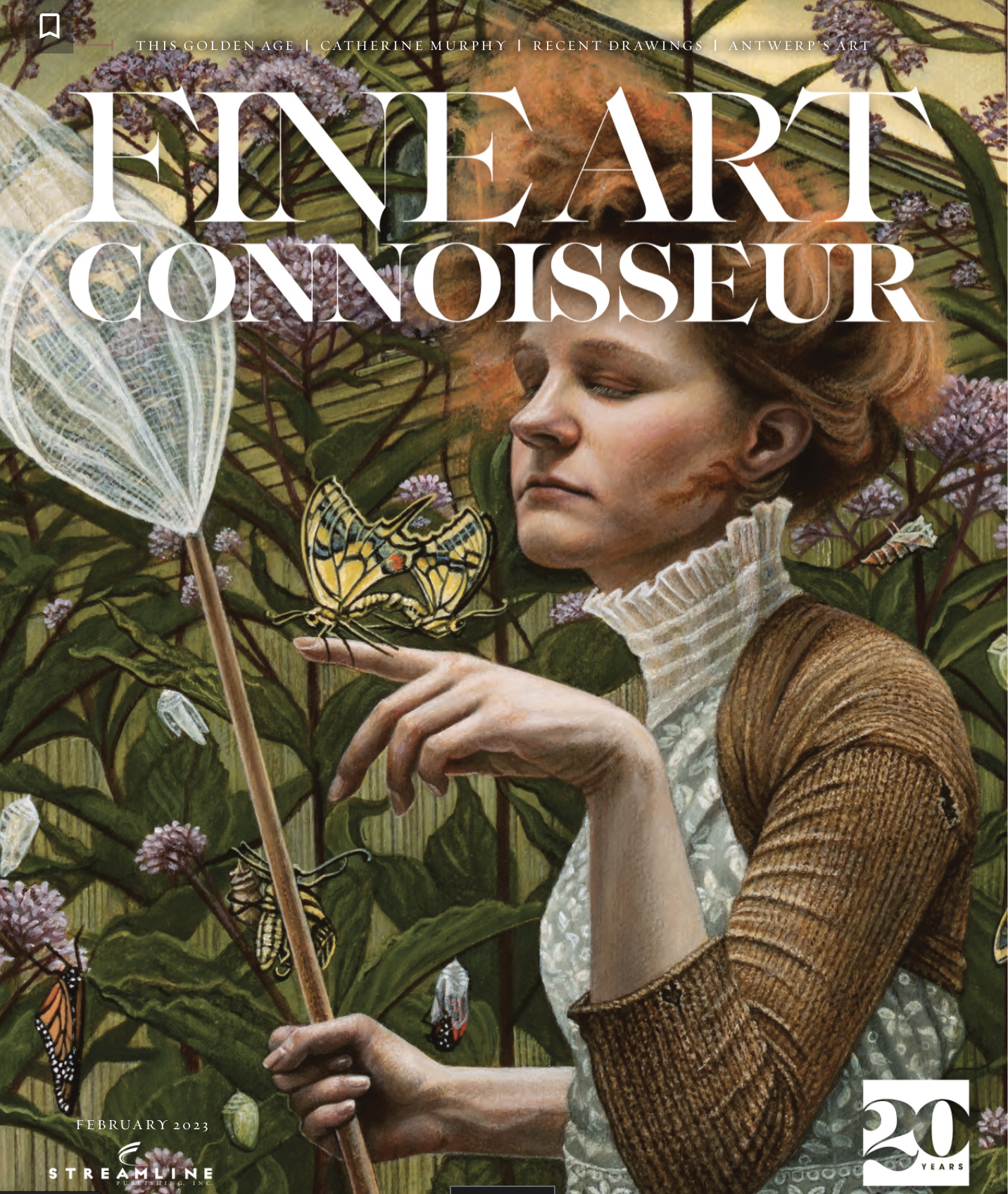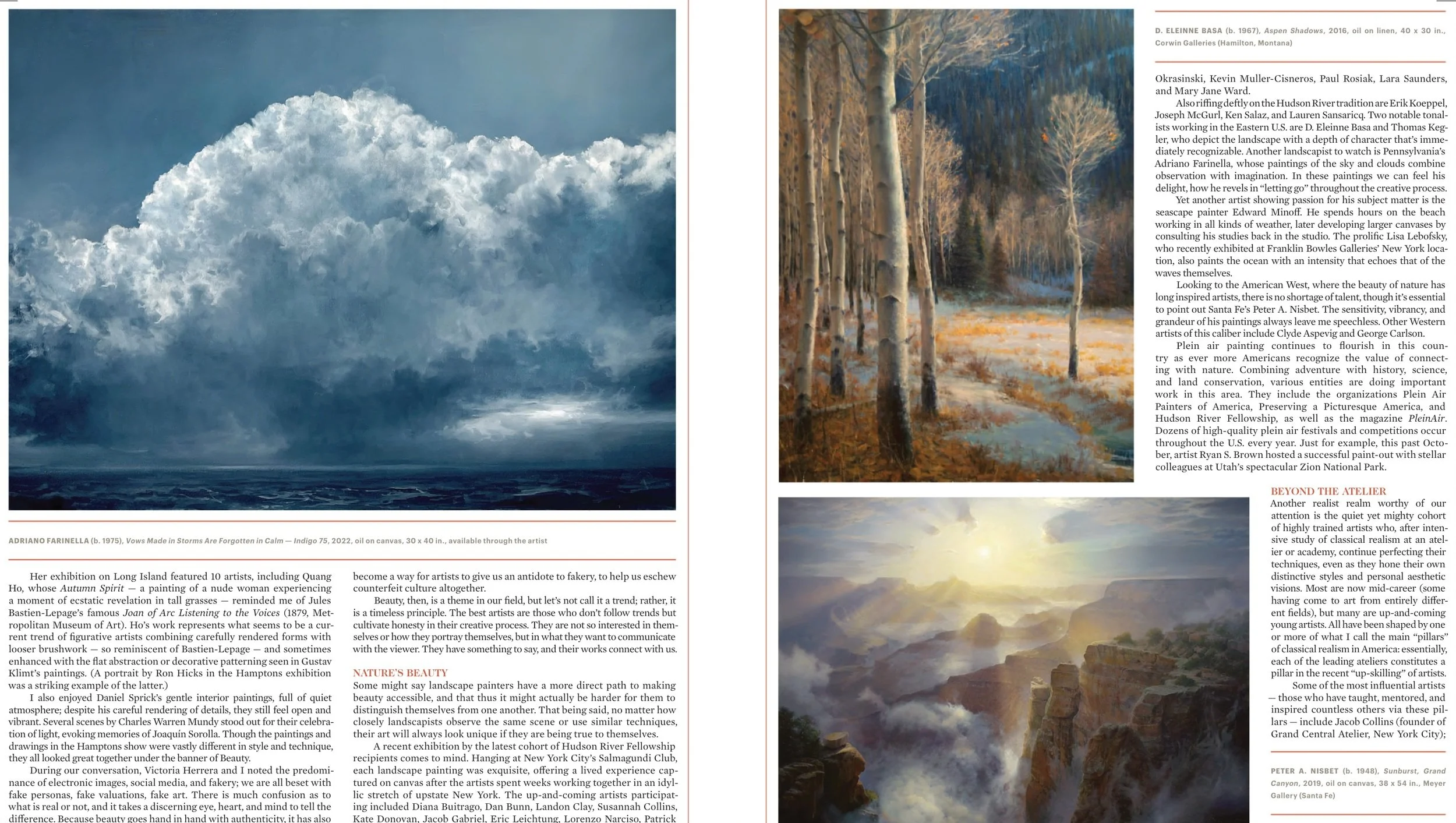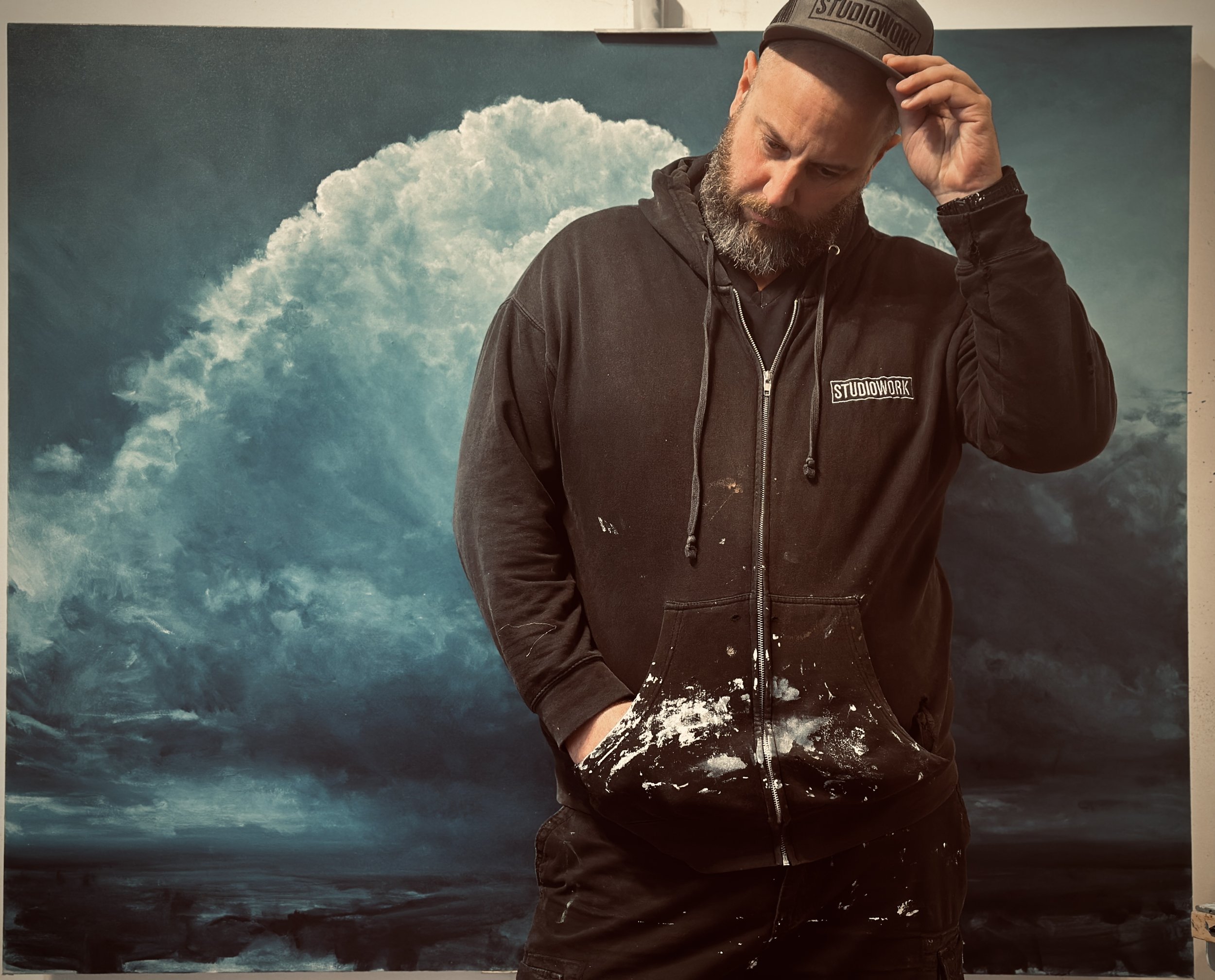
Interviews
Lehigh Valley Style Magazine
May 2025
What an incredible honor. Thank you to Lehigh Valley Style Magazine for this cover and feature. My wholehearted gratitude to Guest Editor Rachel DiCarlo for believing in me and the mission of StudioWork.
Thanks also to publisher Pam Deller, Managing Editor Angela Vennemann, Graphic Designers Eleanor Anderson, Thomas Korp, Elaine Wyborski, Amy Unger for the interview, and the great Marco Calderon for photography.
This is a truly amazing way to begin this next chapter and I’m so thankful for the support and opportunity.
COHART Spotlight Interview
You can read the whole interview and see the attached visuals here.
Spotlight: Adriano Farinella on the Art of Painting from Within
November 2024 | cohart.com
Adriano, an accomplished artist and educator, blends skill-building with intuitive practices at StudioWork, inspiring students globally.
Adriano’s work is widely collected in private and corporate collections throughout the United States. He has taught drawing, figure drawing, painting, and plein air for over 20 years and now owns and operates StudioWork in Easton, Pennsylvania, where he teaches workshops that balance elemental skill building exercises with intuitive painting practices. His flagship online and in-person class, Sky & Clouds & Land & Air, has reached thousands of students across the world.
What inspired you to become an artist, and how did you start your journey?
Although I’m not from a family of fine artists, creativity was always important to everyone and I’m thankful to have had supportive parents who allowed me to pursue it. I grew up surrounded by books of all kinds—children’s books full of illustrations, encyclopedias, science books, novels, and of course, fine art books.
I was always attracted to the arts but the moment that I remember it really switching into a calling was when I was about 12 and saw reproductions of Botticelli’s Birth of Venus and Primavera. Seeing that kind of skill, stylization, and storytelling all working together was so profound it launched me into the pursuit of art making. Around that same time I fell in love with music and started studying and performing it. Music and painting became intertwined, each providing insight into the other and both becoming safe havens for me to explore and grow into.
What is your favorite medium to work with, and why does it resonate with you?
Oil paint is my favorite medium. I adore the body of it and the range it has; I can use it directly for a dynamic sketch or indirectly to build luminous layers. Charcoal and white charcoal on toned paper is also a favorite because, like paint, it can be immediate and bold as well as structured and sensitive.
What role does research play in your artistic process? Do you have a specific method for gathering inspiration?
My landscape paintings are all done from memory and imagination. I don’t use photos to create that work, so my research is more the practice of paying attention to skies and clouds and land and then recalling all of it for the painting. But it’s not a literal, photorealistic recollection that includes every detail, it’s more symbolic and universal. I consider the whole process of observation to recollection, to starting on a blank canvas, to finishing a painting as a sort of working meditation.
I also love the improvisational quality of painting without a photo source. I just start with a vague idea or relationship to a series or title and then find my way through the painting process to an image. These invented landscapes use clouds as protagonists and symbols of impermanence while the land acts as an eternal counterbalance. Rather than being a recording of a specific place at a particular time of day, the paintings refer to a metaphysical version of 'a place in time’ and are intended to connect the viewer to broad contemplations that simultaneously transcend the temporal world and root into it.
How has your artistic vision evolved over time, and where do you see it heading in the future?
If there’s one thing I’m thankful for, it's the evolution of my artistic vision. I used to feel anchored to classical realism and like I had to make work that fit under that heading. I truly love that world but I experienced an amazing epiphany when I started painting more directly and expressively. It felt like I could finally hear the language of painting as I was meant to hear it which led me to love the process of discovering how I would use it and what I would say. What I’ve learned is that it doesn’t have to be either/or. I don’t have to be academic and classical or contemporary and abstracted. I can be singularly myself and make the work I want to make using all that has influenced me up to now. That’s where the power and magic lives and where I feel most at home.
How do you stay motivated and inspired during creative blocks or challenging times?
I don’t know that I’ve ever experienced times that are not challenging but I do know that I would rather have the challenges that come along with pursuing my own dreams than the ones that come from working endless hours in pursuit of someone else’s. I’ve done that before many times in order to make a living but I’m at the point now where I just won’t do that again. My dream of thriving as a working artist is my daily motivation and that means selling my paintings all over the world, growing my educational programming, helping my students to hone their skills and find their voice, and building a life of joy and not just constant work.
But like everyone, there are times when even clear motivations are just not enough. When I feel like I’m empty and discouraged, I spend some time sitting with that and trying to figure out where it’s coming from. Then I remind myself that this life is temporary and short and I am fortunate to be alive and well. I’m also fortunate to have something to offer the world in the way of my work, my support, my advocacy. Acknowledging that usually helps me crawl out of the hole and keep going. But also, I’m learning it’s ok to rest. It’s ok to regroup after extended periods of output and it’s ok to refine and even redefine your purpose as often as is necessary. And it’s definitely ok to ask for help when you need it.
Are there any upcoming projects or exhibitions that you're particularly excited about?
On May 10, 2025, I’ll finally be holding the grand opening of my studio and gallery space. It’s called StudioWork and although I’ve been teaching the educational programming for a few years in this space, this spring will see the official launch. StudioWork is located in Easton, Pennsylvania and has a comprehensive mission to become a forum, a resource, and a supportive community for working artists by providing time, space, guidance and path to a fulfilling creative practice. The studio’s teaching mission is structured around balancing technical skill development and the work required to conjure and sustain a creative practice. Programming consists of short term workshops and ong term classes and mentorships in drawing, painting, plein-air painting, figure drawing and painting, plus a visiting artist series.
How do you approach the concept of success or failure in your art practice?
I have to be careful with attaching too much weight to either of those words because they both have the potential to sink me. Instead, I’m devoted to progress. Failure is my mentor. My biggest strides forward have come from abandoning the fear of failure and doing everything I’m terrified of anyway; redefining that aspect of the creative process as necessary and wholly beneficial because it points out what’s not working or aligned with my highest vision or coming from the most authentic place. Sometimes success is defined as course-correcting and finding my way back to where I need to be.
How do you balance commercial aspects of being an artist with your creative vision?
The commercial aspects are ultimately part of the greater creative vision. Yes, I am an artist. But I am also a business. And currently, I have to play every role in that business. None of that diminishes my creative vision. In fact, it strengthens it because everything I do is in service to growing that vision. The bottom line is self awareness and staying true to what is most important to you.
Does technology play a role in your art-making process?
It never really did until I started teaching my workshops online in 2020. I started using photoshop to virtually paint on student work and it was a revelation because I started using it on my own sketches to try possible color choices out before applying them in real paint on canvas. My online class is full of tech.
I use the amazing Ecamm Live software to produce a class that feels a bit like a tv show or live streaming event with multiple cameras and the ‘live audience’ of students. It has allowed me to truly expand how I teach painting because I can use multiple cameras, overlays, keynotes, all while having real-time student participation. I can paint live demos but also cut to dozens of pre recorded demos of large scale paintings and narrate step-by-step technique. I can craft lectures with endless visual resources and have daily Q&A sessions. The best part is all classes are recorded in HD and each student has access to rewatch and follow along with each brushstroke. It’s changed everything for me and I’m super thankful for it.
What advice would you give to emerging artists or other artist peers trying to find their voice in the art world?
I think it’s important to know that there are many different art worlds. You can carve your space into any of them or invent your own world and invite others into it. Either way, the most important thing is to devote yourself to your creativity and your craft. Nurture it, listen to it, meet your creative self wherever it is in its development and be careful not to judge it so harshly that you quit. If you show up for your creativity, it will show up for you and grow in every dimension. Progress over perfection always.
FINE ART CONNOISSEUR MAGAZINE
FEBRUARY 2023
An amazing honor to be included in this magazine. Thankful for the great Milène J. Fernàndez for the insightful article.
You can read the full article here.
The
CANVAS REBEL Interview
Meet Adriano Farinella
Stories & InsightsJune 30, 2022
We were lucky to catch up with Adriano Farinella recently and have shared our conversation below.
Adriano, thanks for taking the time to share your stories with us today Are you happier as a creative? Do you sometimes think about what it would be like to just have a regular job? Can you talk to us about how you think through these emotions?
I can’t really say that I’ve ever wanted a ‘regular job’ but I have gone through phases in life as an independent working artist when I’ve wished for more dependable and consistent financial security and envied people who receive regular paychecks every week. The idea of knowing exactly how much money is coming to you every week, every month, every year, is so fascinating to me because it’s been years since I had that kind of security. I admit that sometimes I would love it because financial stress can become debilitating and crush my creative spirit.
So for the past twenty years, I’ve worked on figuring out a way to conjure and sustain a living that provides for survival necessities, allows me to build business capital, and create a comfortable lifestyle that destroys the starving artist archetype while staying true to myself and not burning out.
That takes lots of energy, time, mindfulness, and patience and it doesn’t always work out as I want it to. The reward for staying the course is that I have the freedom to create the life I really want to live. The burden is that there is rarely any time that I am not working.
About two years after I graduated college, I had a ‘regular job’ in a publishing house. I was basically working with illustrators and editors to place artwork in children’s text books. I thought since I loved painting so much and am so committed to building my life as a working artist, it would be easy to just have the security of a steady paycheck and paint on the weekends. It didn’t work that way for me. I performed the job well and even learned to like some aspects of it, but it sucked the life out of me to be in the cubicle environment working eight hours a day on something I wasn’t at all passionate about and then spend two and half hours a day driving in rush hour traffic. Instead of painting, I would spend the weekends recovering from how mentally exhausted and physically drained I felt. That was around 2001 and shortly after 911, the company laid off everyone who they deemed ‘non-essential’. So no matter how much I devoted to the job, I and many others were just cut off and the security was gone. After that experience, I swore to myself that I would never again do anything I didn’t love for a living.
I definitely go through phases as a self employed, independent working artist and teacher where I doubt everything I’m doing, everything I’ve ever done, and all my plans for the future. I’ve spent so much time and energy working on dismantling the starving artist archetype because in my early career it shaped so much of the decisions I made, like taking a job I knew I didn’t like in an environment that I was supremely uncomfortable in because I allowed myself to be convinced by well-intentioned people that the only way to make a living as an artist was to do it on the side.
In some ways, it takes a lot for me to stay the course and continue to believe in myself, my work, and what I have to offer the world. I’ve learned that when I feel that cascade of doubt overwhelm me, it’s usually a signal to take some distance from everything and remember that on my worst day in this struggle, I feel infinitely better than I did on my best day with a ‘regular job’. And that wasn’t about the specific work—it was the inauthenticity was eating away at me. I couldn’t sustain the energy output it took to convince myself that it was ok to put my creativity second.
So, I’ve always been an artist and creative, even when I had to put it aside for a job. But I’ve been much happier since I acknowledged that being an artist isn’t so much my job as it is my purpose.
Adriano, before we move on to more of these sorts of questions, can you take some time to bring our readers up to speed on you and what you do?
I’ve always been creative and felt most comfortable in the arts. I earned a BFA in Fine Arts and had minors in music and philosophy. I’ve also been teaching my entire life. In high school and college, I taught guitar lessons to students of all ages. After college, I started teaching figure drawing at a community arts center and soon after, figure drawing and drawing fundamentals at a community based art school where I taught for the next fifteen years. I now run my own workshops and online classes out of my studio.
Teaching has always been a joy and more than a profession or a job. If I were a billionaire, I’d still teach. Some of the most cherished moments of my life so far have come from guiding students through creative and technical obstacles and witnessing their growth into more confident, working artists.
I teach to the individual and pay attention to the entire creative process, not just the technical aspects of drawing and painting. I consider mindset and intuition to be as important as drawing and painting fundamentals. I consider listening to students to be as important as talking to them. This holistic view of creativity is the foundation that my teaching methodology is built upon and the defining attribute that separates my workshops from others.
In a few months, I’ll officially be launching my company called StudioWork©.
The comprehensive mission of StudioWork is to become a forum, a source, and a supportive community for working artists by providing time, space, guidance and path to a fulfilling creative practice.
The StudioWork programming is an ongoing series of intensive and immersive classes and workshops for the serious practicing artist who aims to balance skill building exercises with intuitive painting practices in order to grow and develop their singular creative voice. This programming isn’t about a specific methodology or specific atelier method but it’s also not a shapeless free-for-all.
The skill building aspects of classes are based on my twenty-four years of teaching hundreds of students. I teach to what I never got as a student and take an approach that is rooted in paying attention to each individual student. The studio’s teaching mission is structured around the pursuit of balance between technical skill development and the work required to conjure and sustain a creative practice.
StudioWork is headquartered at my studio space in Easton, Pennsylvania and my goal is to create a teaching studio where adult students of all skill levels can immerse themselves in highly concentrated study and receive personal instruction, guidance, and thorough critiques of their work while regenerating their creative spirit through practice and skill building exercises in drawing and painting. The programming will be structured as short term study (3, 5, and 7 day workshops) as well as long term study with several 16 week classes, and year long mentorship programs. I plan to expand on this model by not only offering my own workshops in drawing, painting, plein air, but growing to include invitational residency workshops with nationally recognized artists conducting their own workshops in the space.
How about pivoting – can you share the story of a time you’ve had to pivot?
I found my dream studio space in 2019 and after about eight months of prepping the space, I launched my first in-person workshop in January of 2020. It was a great success with people from all over the United States and Canada enrolling and making the trip to Easton. I followed that with launching an entire spring season of workshops and programming which was also well received with great enrollment. The sessions started and it was an absolute joy to teach in this space that I had spent months prepping. Four weeks into that session, the world stopped because of Covid and like every other business, I had to shut down. Also, like every other business, I had to cancel future in person programming indefinitely which meant issuing lots of refunds to students who had signed up for a season worth of classes. As a start-up small business that operates on really thin margins, that was incredibly difficult and scary. I sat with the terror and uncertainty that we all felt in that first few months of lockdown and allowed myself some time to really process it. I knew it was time to reinvent but didn’t know the first thing about how that was going to happen.
Everyone seemed to be moving towards online teaching, which was definitely part of my long-term business plan, but not something I had considered starting until the in-person classes became
more established. I didn’t know what Zoom was and couldn’t imagine how I would teach painting online and make it look professional with high quality visuals. I dove into researching and learned a bit about what kind of tech I would need in order to present the class the way I really wanted to and not like most of the zoom classes I had seen happening at the time.
I started with just my iPhone, a 2013 MacBook Pro, and live streaming software. I quickly fell in love with the whole operation. Suddenly, I had this platform that felt like a whole new world where I could give students everything I give during in-person classes but with the addition of amazing HD visuals of my demos and palette. And the momentum just kept growing from there. I fell even more in love with the software and tech and added more cameras and more content.
My online classes now go way beyond the ‘Zoom’ format and feel more like a television show where students can interact in real time. I use live streaming software and multiple cameras to create an experience as close to my in-person studio environment as possible. Classes begin with short keynote presentations on technique followed by a Q&A with students who are present and can speak their questions out loud in real time, unlike seminar classes where students type questions into a chat. Students then watch me live-demo with a head-on view of my canvas and an up close view of my palette so they can see every brush stroke and paint mix in hi-definition. Students are encouraged to ask questions and comment during demos which leads to amazing and insightful conversations. Classes also include pre-recorded clips of other demos featuring more advanced techniques and extensive Q&A sessions about topics beyond technical aspects such as business of art and career guidance. And students get access to the class recordings to rewatch as many times as they want for the duration of the workshop plus an extra month.
One of my favorite and most unique features of the online workshops was built out of my desire to preserve the personal connection with students despite the online format. So all students receive a weekly 30-minute one-on-one sessions with me as part of their tuition. Each week we meet over zoom where I address their individual questions and provide guidance by virtually painting on their paintings using Photoshop. This practice has become a profound resource for students as it allows for real time solutions to painting problems, direct access to me to ask about anything that they’re struggling with or challenged by in class, and provides space for the students and I to connect as we would in person.
My flagship online workshop called Sky & Clouds & Land & Air has sold out almost every session and grown to include students from all over the world. I’ve been honored to host students from Italy, Germany, France, England, Iceland, Australia, Canada, South America, and nearly every state in the US.
I’ll always offer online classes and currently working on several full courses and workshops for the next half of the year.
Is there a particular goal or mission driving your creative journey?
There are several really. I have business goals, teaching goals, and artist goals.
I am passionate about teaching and building StudioWork into a viable and thriving business. But I am an artist first and live to make paintings and contribute to the world (and hopefully) art history. I have things to say that I haven’t yet said and that go so far beyond the subject matter I am currently most known for. Honestly, I feel like I’m just starting to find the voice that I want to use and I am ready to immerse myself in my creative practice and use it for the greater good.
Teaching the online workshops is amazing as I stated above, however it takes an extraordinary amount of energy and mental bandwidth to do it. This past eight week winter session, I spent a minimum of 14 hours a day either filming demos, editing the footage, narrating the final videos, or else in one-on-one zoom sessions with students which averaged about 12 a day. When that session ended, I was burnt out and drained. I’m so happy for having done it and thrilled with the connections I made with students, but I still feel flattened out and it takes weeks and sometimes months to feel full again. A big goal I have is to balance teaching with being a thriving working artist and still make time to enjoy my life and take care of myself.
And with that, one of my goals as an artist, teacher, and business owner is to once and for all destroy the starving artist mythology. I have grown to loathe the proliferation of that ridiculous nonsense and will gladly be an advocate and coach for anyone who needs help breaking free from it. There is an overwhelming amount of smug dismissal of the role of artists and creatives in this country and I have zero tolerance for it. Creativity, artists, and art education are absolutely necessary and worth defending. I’m always ready to do my part to inform the uninformed, support artists and art students of any age who need supporting, and advocate for art education.
Contact Info:
Website: https://www.adrianofarinella.com/
Instagram: https://www.instagram.com/adrianofarinella
Facebook: https://www.facebook.com/adrianofarinellastudio
Twitter: https://twitter.com/afthestudio
Youtube: https://www.youtube.com/channel/UCFbS0_h-DHjXT1mTOx42Htg

